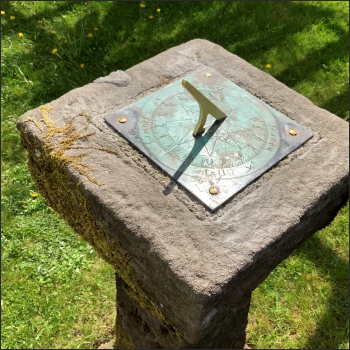 This small brass garden sundial had lost its gnomon. It is dearly loved by its owner who has known it since childhood, and she wanted to have it restored. As often happens at different times the family moved home and the sundial moved too. Continue reading
This small brass garden sundial had lost its gnomon. It is dearly loved by its owner who has known it since childhood, and she wanted to have it restored. As often happens at different times the family moved home and the sundial moved too. Continue reading
sundial
The last of our songbird sundials flies to Paris
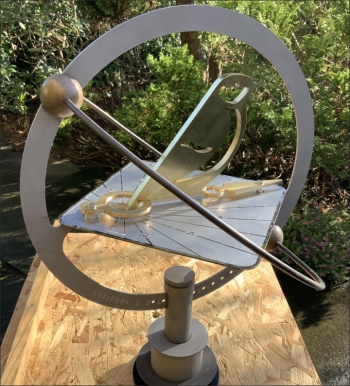
This design is a form of universal sundial. It is adjustable and we build it for its intended latitude.
The last of our songbird sundials has flown away. It now has a new home in a new country, in Paris. This special design appeals to the eye and has intriguing gnomonic features. The new owner already knew that the Orbdial was the one they wanted. Continue reading
Our replica of the lighthouse sundial is now complete
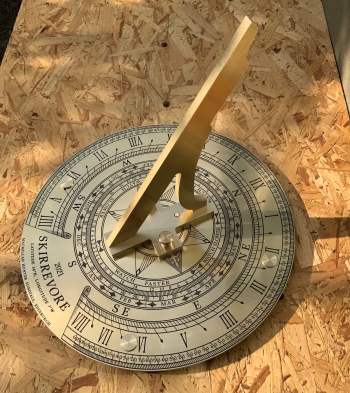
A replica lighthouse sundial made in naval brass and copied in detail from a similar one held in the National Museum of Scotland at Edinburgh.
Our replica lighthouse sundial is complete now. We handed it over to its new owner, who came to collect it from us in Edinburgh in September. “This is wonderful,” he said. “It is even better when I see it than I ever imagined. This sundial will go right in the centre of my lighthouse display.” Continue reading
Rustic stone sundial in an Edinburgh garden
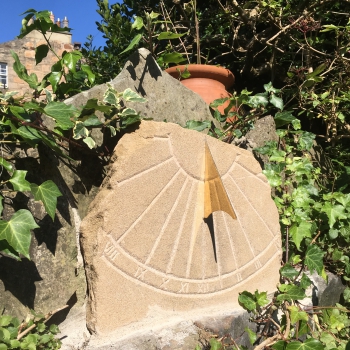
This sundial is delightful. It is the first piece of work by someone in Edinburgh who is learning to do stone carving. It is a very good sundial and they should be proud.
A sundial carved in stone is always special. This sundial is the first piece of work by a stone carver who has begun learning the craft of carving for their own pleasure. The result is very good. The rustic design suits the sunny spot on their slightly overgrown wall in the garden in Edinburgh so well.
Even a rustic design has to follow the sundial rules for the angles of lines on the dial and the angle of slope of the gnomon. Continue reading
Restoration of an Atlas figure armillary sundial
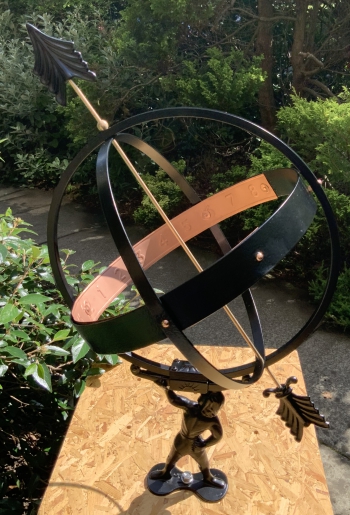
After years of gradual deterioration outdoors the sundial was in poor condition. The Atlas figure was hard to recognise. This is an Art Deco design from the 1930’s. It has now come back to life as a working armillary sundial after complete restoration.
This armillary sundial was once in poor condition. It had been outside in the garden for a long time, and the owners asked us to restore it for them. The Atlas figure that supports the rings, and the arrowhead and tail, were badly tarnished. Continue reading
The impossible Dihelion sundial photo
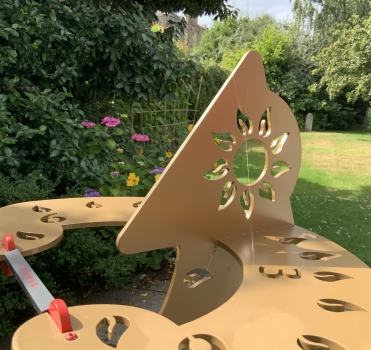
We shot this impossible photo blind because there is no room to stand between the sundial and the house wall.
Dihelion is our well-known dual sundial design, which reads solar time and solar declination. It is impossible to take this photo in the normal way because the sundial is too close to the house, and there is nowhere to stand. So the photo was taken by holding the camera against the house and shooting blind. At a first attempt, the picture has turned out well. Continue reading
An armillary sundial in early morning

This is our new sundial design. It stands in our garden among the plants. It is early morning and the sun has just reached the centre band where you read the time.
An armillary sundial has a wonderful form. It has mathematical rings creating beautiful shapes with circles and lines. The sundial in the photo has just begun to catch the early morning sun in the garden.
The sundial gnomon is the slanting rod in the centre of the rings, and the wide sweeping band is where you can read the time. These features are the same as other armillaries, but our design has special secrets. Continue reading
Modern techniques for a replica sundial exhibit
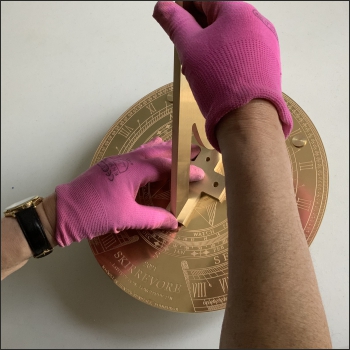
Details for making the sundial came from archive records and photos. This image shows the design and successful first assembly of the new parts.
The replica of a 19th century lighthouse sundial we are making will be part of a mobile exhibition. It is progressing well. Lighthouse sundials were made by skilled instrument makers, who worked mainly with hand tools. We are using modern techniques for cutting out the metal and etching the intricate design on the dial plate. The picture shows our first trial to assemble the dial and gnomon parts. Continue reading
What is the declination of the wall for a sundial

Knowing the declination of the wall (WD) is important for designing a sundial. The basic calculation is azimuth angle (AA) minus protractor angle (PA) plus 90°. You can repeat your measurements for accuracy. Do ask for help if you are unsure.
“What is the declination of the wall for a sundial?” A stone sculptor asked us just this question recently . It is a good question because you must know the declination if you are making a sundial that is accurate for the wall. The sculptor was not confident about their own measurements and calculations so they asked us for help. Continue reading
A lighthouse sundial replica for display
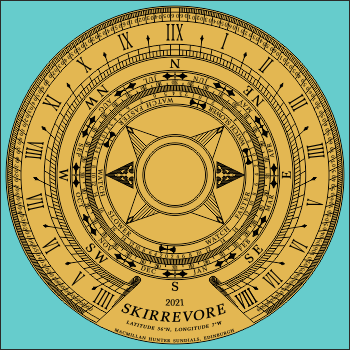
This is the finished artwork for creating the sundial plate. The graduated lines and gnomonic information will be transferred onto a prepared blank plate using the technical process of photoetching.
For centuries, the lighthouses round the rocky coasts of Britain have been a lifeline to ships at sea. The lighthouse keeper used a sundial to find the time. It was part of lighthouse equipment before telegraph, radio and automation eventually took over. We have been asked to make a replica of one of these sundials.
The replica is for a travelling display of Scottish lighthouse memorabilia, which the owner will use when he gives one of his regular talks on lighthouses to interested groups of people. He has built up a significant collection of items but a sundial is an essential missing piece he has been unable to obtain so far. Continue reading
